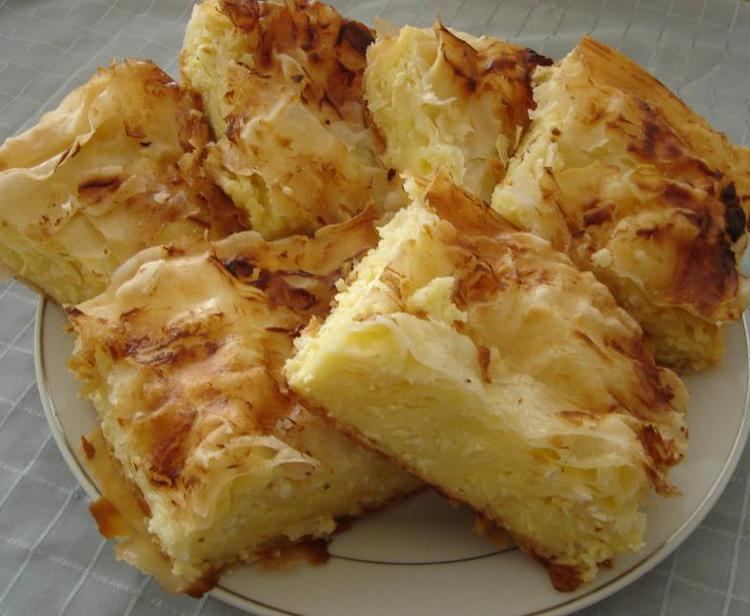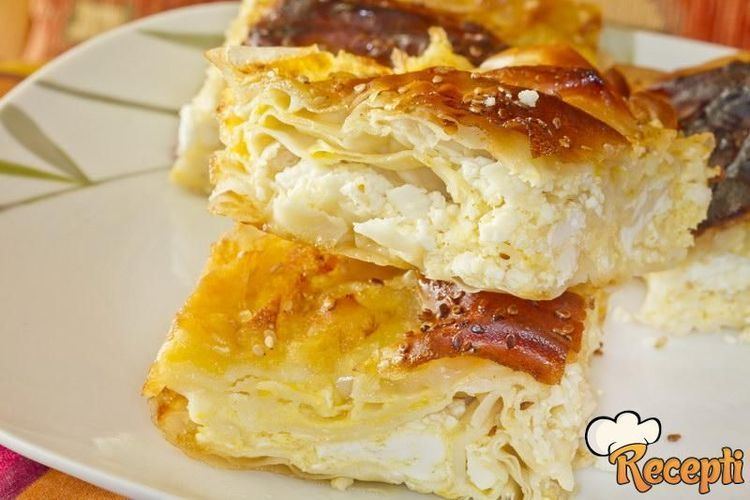Alternative names Gužvara (Crumpled pie) | Type Pastry Serving temperature Hot or cold | |
 | ||
Similar Prekmurska gibanica, Proja, Nut roll, Međimurska gibanica, Strudel | ||
Gibanica (Serbian Cyrillic: Гибаница, [ˈɡibanit͡sa]) is a traditional pastry dish from Serbia popular all over the Balkans. It is usually made with white cheese and eggs. Recipes can range from sweet to savoury, and from simple to festive and elaborate multi-layered cakes.
Contents
- Recept gibanica doma a sastojci i priprema kako se sprema deutscher untertitel english subs
- Etymology
- History
- Preparation
- Variants
- In culture
- References

A derivative of the Serbian verb gibati, meaning "to fold; sway, swing, rock", the pastry was mentioned in Serbian linguist Vuk Stefanović Karadžić's Serbian dictionary in 1818. It is traditionally served for breakfast with kefir or plain yogurt. Other than in the Balkans, Gibanica can be found worldwide in restaurants serving Serbian cuisine. It is one of the most popular and recognizable pastry dishes from the Balkans, whether served on festive occasions, or as a comforting family snack. In Serbia, the dish is often consumed at traditional events such as Christmas, Easter and Slava.

Recept gibanica doma a sastojci i priprema kako se sprema deutscher untertitel english subs
Etymology

In the vocabulary of the Yugoslav Academy, as well as in the etymological dictionary of Slavic languages, the word gibanica is a derivative of the Serbian verb gíbati/ги́бати, which means "to fold; sway, swing, rock". There are also word derivatives like the Serbo-Croatian word gibaničar/гибаничар (one who makes gibanica, one who loves to eat gibanica, and one who always imposes as a guest and at someone else's expense.)
History

The word gibanica was first mentioned in the Balkans in the 17th century as a last name, or nickname. The Serbian word gìbanica/гѝбаница was included in the Serbian dictionary, written in 1818 by Serbian philologist and linguist Vuk Stefanović Karadžić. Karadžić traveled widely in the Balkans and recorded interesting facts relating to Serbian tradition and customs. He explained that gibanica "is a pie with soft cheese between the dough mixed with kaymak, milk and eggs."
During the Second World War, while hiding from Nazi German forces in the forests of Yugoslavia, Serbian Chetniks made the so-called Chetniks Gibanica from ingredients that they had received from peasants. When the commander of the Yugoslav Partisans, Josip Broz Tito, and Chetnik leader Draža Mihailović met at Ravna Gora in 1941, Gibanica and potato under sač with kaymak were served specifically for them.
In 2007, the Gibanica officially became an export brand of Serbia. At the Brand Fair in Belgrade, the food industry "Alexandria" presented a half-baked and frozen gibanica for the international market.
Preparation
The original recipe for Gibanica included traditionally homemade phyllo dough and cow's milk cheese. Homemade cheese can be feta or sirene. The pie is usually made as "Gužvara" (Crumpled pie), so the phyllo dough in the middle is crumpled and filled. Besides cheese, the fill contains eggs, milk, kaymak, lard, salt and water. Also, stuffing may include spinach, meat, nettle, potato and onion. In order to speed up preparation, phyllo dough from a store can be used and sunflower oil or olive oil can be used instead of lard.
Gibanica is a round-shaped pastry with crispy golden-brown crust. The inside is multi-layered, and includes crumpled dough with small pieces of cheese between each layer. Gibanica can be served hot in the morning and is commonly accompanied by yogurt.
Variants
Many varieties of Gibanica and related dishes can be found throughout the Balkans; different gibanica are known as part of the national cuisines of Bosnia and Herzegovina, Croatia, the Republic of Macedonia, Serbia, Slovenia, and Friuli-Venezia Giulia (Italy, where it is called ghibanizza), Greece, and Bulgaria, where it is usually called Banitsa.
From the basic recipe, many local specialties have evolved. Prekmurska gibanica, for example, is a "fancy" multi-layered cake from Prekmurje in Slovenia, served as a dessert course on festive occasions. Međimurska gibanica, from the neighbouring Međimurje region of Croatia, is a closely related but simpler and less "formal" dish consisting of four layers of fillings (prepared fresh cheese (quark), poppyseed, apple and walnut). Another gibanica variety, called Prleška gibanica, is known from Prlekija to the west of the Mur River.
The basic concept of Gibanica, a cake or pie involving a combination of pastry with cheese in differentiated layers often combined with layers of various other fillings, is common in the cuisines of the Balkans, Anatolia, and the Eastern Mediterranean. For example, a similar dish known as Shabiyat (Sh'abiyat, Shaabiyat) is part of the cuisine of Syria and Lebanon. Gibanica can also be considered to resemble a type of cheese strudel, with which it likely shares a common ancestry in the pastry dishes of the region, and the cuisines of the Byzantine and Ottoman empires.
In culture
Gibanica is one of the most popular and recognizable pastry dishes from the Balkans, whether served on festive occasions, or as a comforting family snack. In Serbia, the dish is often consumed at traditional events such as Christmas, Easter and Slava. According to the Serbian media, the largest Gibanica ever made was in the town of Mionica in 2007. It weighed over 1,000 kg, and was applied for inclusion in the Guinness Book of Records. 330 kg of phyllo dough, 330 kg of cheese, 3,300 eggs, 30 l. of oil, 110 l. of mineral water, 50 kg of lard and 500 packets of baking powder went into its creation. In Serbia, as well as in neighboring countries, there are festivals dedicated to pies. One of them, called the Gibanica festival or Days of Banitsa, is held each year in Bela Palanka. It first took place in 2005.
